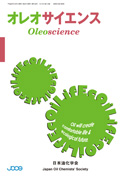
- |<
- <
- 1
- >
- >|
-
Azusa SAIKA2020 Volume 20 Issue 5 Pages 187-193
Published: 2020
Released on J-STAGE: May 09, 2020
JOURNAL FREE ACCESSMannosylerythritol lipids (MELs) are glycolipid type of biosurfactant and attracting attention as environmental-friendly functional chemicals due to their unique properties, such as gene delivery, bio-activation, anti-oxidative activity and damage skin and hair repair. MELs are expected to apply in many industrial fields, including cosmetics, pharmaceutical, agriculture and food. However, the industrial use of MELs is require overcoming some issues, e.g. limited structural variety and higher production costs. Recently, whole-genome analysis of MEL producers has progressed rapidly, and it allowed to obtain the genomic information of MEL biosynthesis pathway and establish genetic tools for modification of MEL producers. In this review, we summarize the genetic engineering techniques for modification of MEL producing yeast strains and introduce the examples for increasing productivity and producing tailored MEL using genetic modification in genus Pseudozyma.
View full abstractDownload PDF (1276K) -
Tomohiro SUGAHARA, Shuhei YAMAMOTO, Atsushi SOGABE2020 Volume 20 Issue 5 Pages 195-202
Published: 2020
Released on J-STAGE: May 09, 2020
JOURNAL FREE ACCESSMannosylerythritol lipid-B (MEL-B) is extracellular glycolipid produced by yeast, Pseudozyma tsukubaensis. MEL-B shows unique interfacial properties and physiological functions not found in synthetic surfactants. MEL-B has excellent skin moisturizing effect, lamella-forming ability and unique good touch feeling, and therefore has come to be widely used for cosmetic ingredient. Besides, the research on cosmetic formulation has been advanced, and characteristic formulations using MEL-B has been reported recently. We here summarize the cosmetic applications of MEL-B from basics research including the effect on the skin and its mechanism to applied research including cosmetic formulation and sensory evaluation.
View full abstractDownload PDF (1428K) -
Tatsuyuki KOSHIYAMA2020 Volume 20 Issue 5 Pages 203-208
Published: 2020
Released on J-STAGE: May 09, 2020
JOURNAL FREE ACCESSAdjuvants have been used worldwide to improve the efficiency of crop protection products. There are a wide variety of adjuvants such as surfactants, oils, solvents and salts. Development of safer crop protection products including adjuvants would be anticipated with growing demand for sustainable agriculture. Biosurfactants which are surface-active agents produced by various microorganisms have unique properties such as low critical micelle concentration, low toxicity, biodegradability and environmentally friendly nature. Hence, using biosurfactants as adjuvants for agrochemicals has a potential of better adjuvant effect and safer properties than using chemical adjuvants. The purpose of this study is to evaluate the use of biosurfactants as adjuvants in the field of crop protection. We investigated the enhancing fungicide efficacy of several biosurfactants against the plant diseases in pot test for screening of adjuvants. Among the tested biosurfactants, mannosylerythritol lipids (MELs) showed the best efficacy, and apparently enhanced the efficacy of coexisting fungicide. Here, I present the efficacy trials for the MELs compared with existing chemical adjuvants in greenhouse or field.
View full abstractDownload PDF (567K) -
Daisuke TAKAHASHI, Kazunobu TOSHIMA2020 Volume 20 Issue 5 Pages 209-214
Published: 2020
Released on J-STAGE: May 09, 2020
JOURNAL FREE ACCESSMannosylerythritol lipids (MELs) are glycolipid biosurfactants that show significant biochemical and physicochemical properties, such as antibacterial and surface activities. However, since heterogeneity always exists in MELs obtained from microbial products, especially with respect to the chain length of the fatty acids, chemically synthesized homogeneous and structurally well-defined MELs are required to elucidate the detailed structure-function relationships. Therefore, in this study, the total synthesis of the 20 homogeneous members of MEL-A-D (4 kinds) with different alkyl chain lengths (5 kinds) was effectively and systematically accomplished from our designed common key intermediate, which was stereoselectively synthesized by a recently developed our borinic-acid-catalyzed stereoselective β-mannosylation reaction. In addition, their antibacterial activities against Gram-positive bacteria were evaluated.
View full abstractDownload PDF (881K)
- |<
- <
- 1
- >
- >|